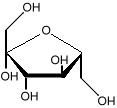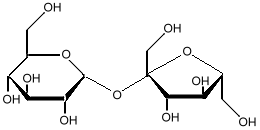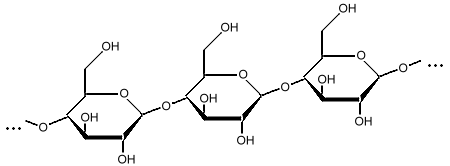Ingredients --
Sugars
Chemical Formula:

|

|
| Glucose | Fructose |
 Sucrose
Sucrose

|

|
| Galactose | Mannose |
Synonyms
DextroseInvert sugar
Corn Syrup
High Fructose Corn Syrup
Description
White crystals or powder.Uses
Sugars are used as sweeteners, as thickeners, and as structural elements in foods. Table sugar is sucrose. It is made from two simpler sugars called glucose and fructose. Glucose is sometimes called dextrose. Glucose is a little less sweet than sucrose, and fructose is a sweeter than sucrose. When sucrose is heated in the presence of an acid (such as vinegar or lemon juice), it breaks down into glucose and fructose, and the resulting syrup is sweeter than sucrose. The syrup is called "invert sugar". Simple sugars can join to form long chains. Glucose units can chain up to form amylose, Amylose
the starch in corn, or
cellulose
Amylose
the starch in corn, or
cellulose
 Cellulose
the molecule that forms the structure of plants.
Amylose can be broken down into its simple glucose units using
enzymes. The result is called "corn syrup". Processing it some
more using enzymes that convert glucose into fructose, yields
"high fructose corn syrup". The mixture of glucose and fructose
is similar to that in sucrose and invert sugar, and it is sweeter
than plain corn syrup.
There are many different types of simple sugars, and they can
combine into many more types of complex sugars. The backbone
of DNA is a chain made of sugars.
Cellulose
the molecule that forms the structure of plants.
Amylose can be broken down into its simple glucose units using
enzymes. The result is called "corn syrup". Processing it some
more using enzymes that convert glucose into fructose, yields
"high fructose corn syrup". The mixture of glucose and fructose
is similar to that in sucrose and invert sugar, and it is sweeter
than plain corn syrup.
There are many different types of simple sugars, and they can
combine into many more types of complex sugars. The backbone
of DNA is a chain made of sugars.
fructose: InChI=1/C6H12O6/c7-1-3-4(9)5(10)6(11,2-8)12-3/h3-5,7-11H,1-2H2
galactose: InChI=1/C6H12O6/c7-1-2-3(8)4(9)5(10)6(11)12-2/h2-11H,1H2/t2-,3+,4+,5-,6?/m1/s1
lactose: InChI=1/C12H22O11/c13-1-3-5(15)6(16)9(19)12(22-3)23-10-4(2-14)21-11(20)8(18)7(10)17/h3-20H,1-2H2/t3-,4-,5+,6+,7-,8-,9-,10-,11u,12+/m1/s1
maltose: InChI=1/C12H22O11/c13-1-3-5(15)6(16)9(19)12(22-3)23-10-4(2-14)21-11(20)8(18)7(10)17/h3-20H,1-2H2/t3-,4-,5-,6+,7-,8-,9-,10-,11u,12-/m1/s1
mannose: InChI=1/C6H12O6/c7-1-2-3(8)4(9)5(10)6(11)12-2/h2-11H,1H2/t2-,3-,4+,5+,6?/m1/s1
sucrose: InChI=1/C12H22O11/c13-1-4-6(16)8(18)9(19)11(21-4)23-12(3-15)10(20)7(17)5(2-14)22-12/h4-11,13-20H,1-3H2
By Simon Quellen Field